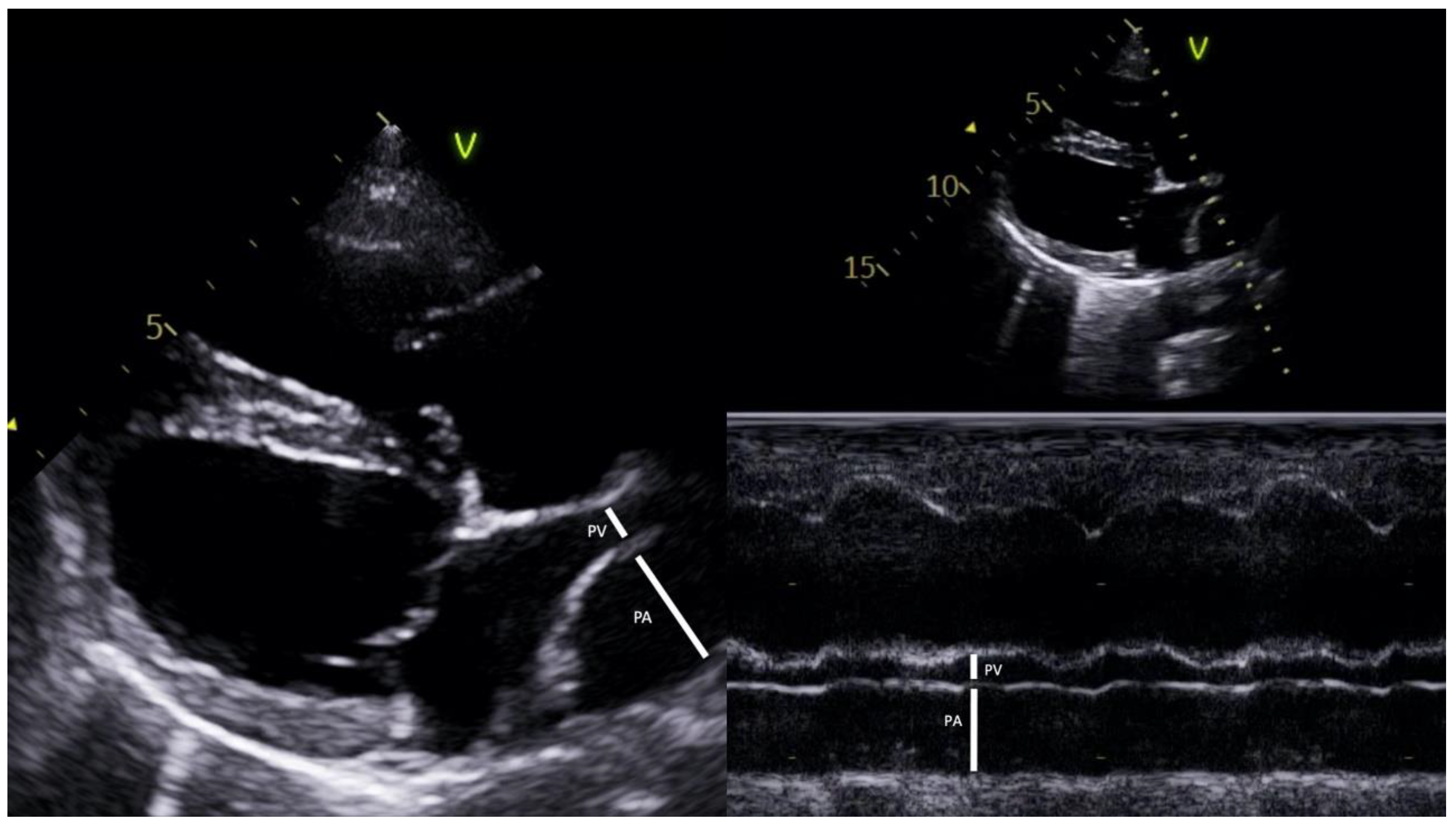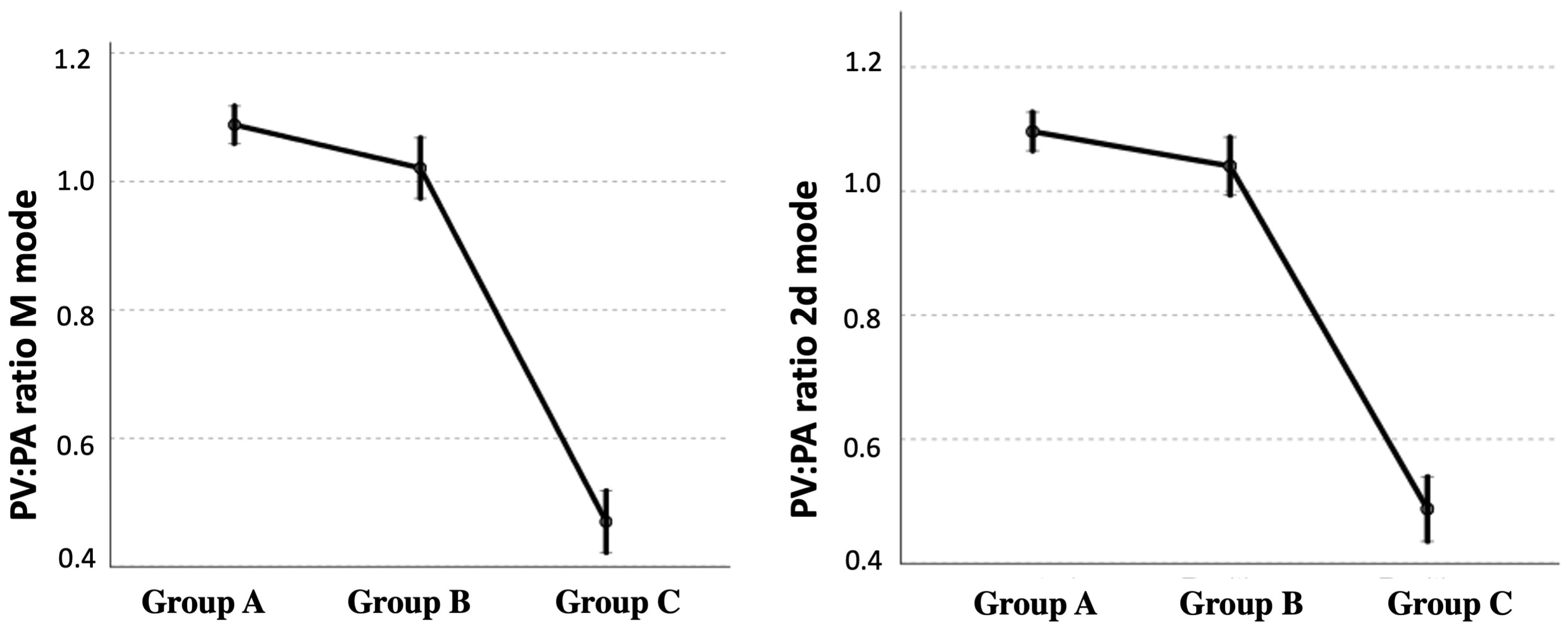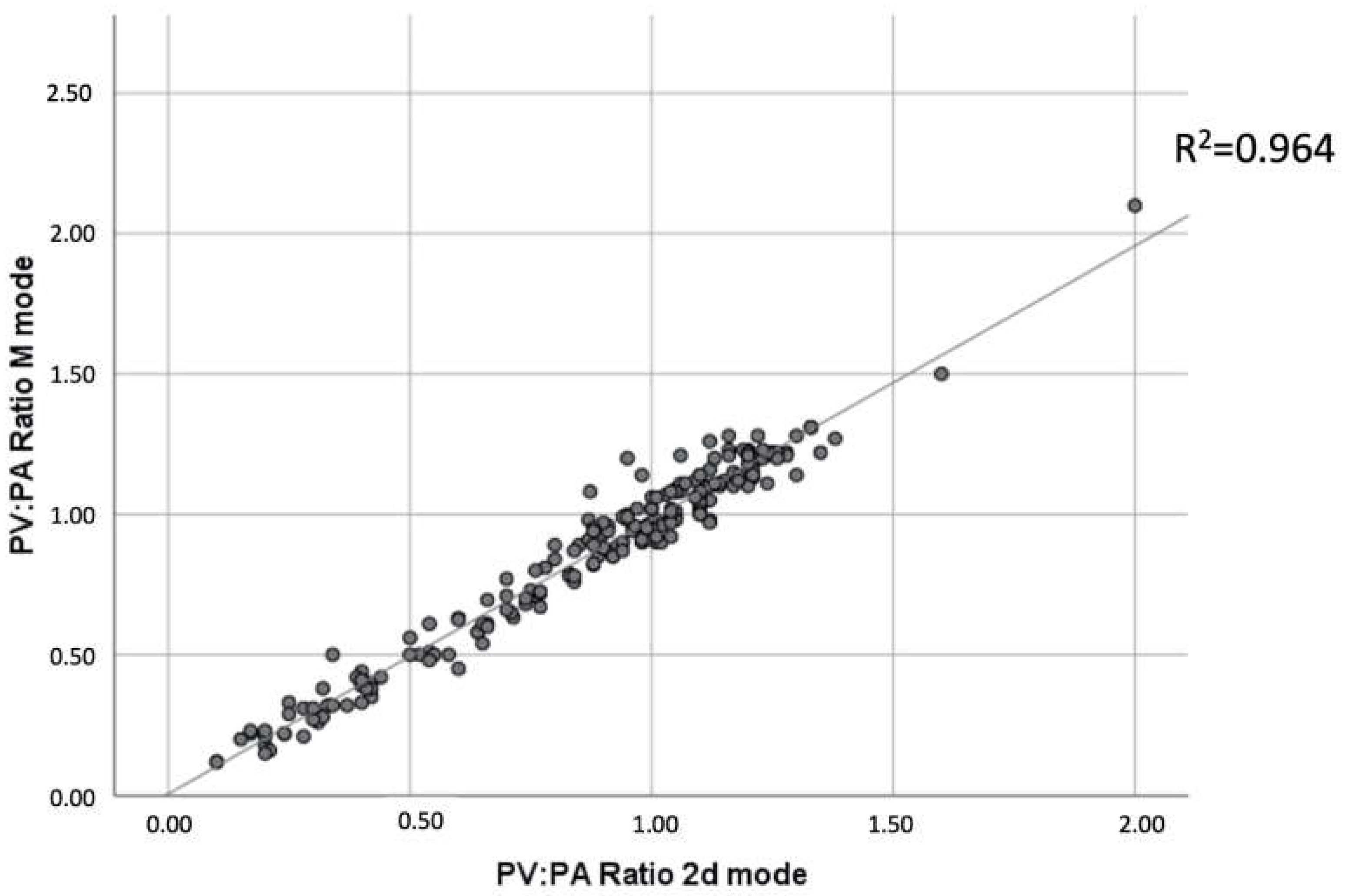Echocardiographic Assessment of the Pulmonary Vein to Pulmonary Artery Ratio in Canine Heartworm Disease
Abstract
Simple Summary
Abstract
1. Introduction
2. Methods
2.1. Study Animals
2.2. Echocardiography
2.3. Statistical Analysis
3. Results
4. Discussion
5. Conclusions
Author Contributions
Funding
Institutional Review Board Statement
Informed Consent Statement
Data Availability Statement
Acknowledgments
Conflicts of Interest
References
- Maerz, I. Clinical and diagnostic imaging findings in 37 rescued dogs with heartworm disease in Germany. Vet. Parasitol. 2020, 283, 174–181. [Google Scholar] [CrossRef] [PubMed]
- Serrano-Parreño, B.; Carretón, E.; Caro-Vadillo, A.; Falcón-Cordón, Y.; Falcón-Cordón, S.; Montoya-Alonso, J.A. Evaluation of pulmonary hypertension and clinical status in dogs with heartworm by Right Pulmonary Artery Distensibility Index and other echocardiographic parameters. Parasites Vectors 2017, 10, 106–112. [Google Scholar] [CrossRef] [PubMed]
- Reinero, C.; Visser, L.C.; Kellihan, H.B.; Masseau, I.; Rozanski, E.; Clercx, C.; Willians, K.; Abbot, J.; Borgarelli, M.; Scansen, B.A. ACVIM consensus statement guidelines for the diagnosis, classification, treatment, and monitoring of pulmonary hypertension in dogs. J. Vet. Intern. Med. 2020, 34, 549–573. [Google Scholar] [CrossRef] [PubMed]
- Romano, A.E.; Saunders, A.B.; Gordon, S.G.; Wesselowski, S. Intracardiac heartworms in dogs: Clinical and echocardiographic characteristics in 72 cases (2010–2019). J. Vet. Intern. Med. 2021, 35, 88–97. [Google Scholar] [CrossRef] [PubMed]
- Falcón-Cordón, Y.; Montoya-Alonso, J.A.; Caro-Vadillo, A.; Matos, J.I.; Carretón, E. Persistence of pulmonary endarteritis in canine heartworm infection 10 months after the eradication of adult parasites of Dirofilaria immitis. Vet. Parasitol. 2019, 273, 1–4. [Google Scholar] [CrossRef] [PubMed]
- Venco, L.; Mihaylova, L.; Boon, J.A. Right Pulmonary Artery Distensibility Index (RPAD Index). A field study of an echocardiographic method to detect early development of pulmonary hypertension and its severity even in the absence of regurgitant jets for Doppler evaluation in heartworm-infected dogs. Vet. Parasitol. 2014, 206, 60–66. [Google Scholar] [PubMed]
- Patata, V.; Caivano, D.; Porciello, F.; Rishniw, M.; Domenech, O.; Marchesotti, F.; Giorgi, M.E.; Guglielmini, C.; Poser, H.; Spina, F.; et al. Pulmonary vein to pulmonary artery ratio in healthy and cardiomyopathic cats. J. Vet. Cardiol. 2019, 27, 23–33. [Google Scholar] [CrossRef] [PubMed]
- Roels, E.; Fastrès, A.; Merveille, A.C.; Bolen, G.; Teske, E.; Clercx, C.; Entee, K.M. The prevalence of pulmonary hypertension assessed using the pulmonary vein-to-right pulmonary artery ratio and its association with survival in West Highland White terriers with canine idiopathic pulmonary fibrosis. BMC Vet. Res. 2021, 17, 171–177. [Google Scholar] [CrossRef] [PubMed]
- Roels, E.; Merveille, A.C.; Moyse, E.; Gomart, S.; Clercx, C.; Entee, K.M. Diagnostic value of the pulmonary veinto-right pulmonary artery ratio in dogs with pulmonary hypertension of precapillary origin. J. Vet. Cardiol. 2019, 24, 85–94. [Google Scholar] [CrossRef] [PubMed]
- Montoya-Alonso, J.A.; Morchón, R.; Costa-Rodriguez, N.; Matos-Rivero, J.I.; Falcón-Cordón, Y.; Carretón, E. Current Distribution of Selected Vector-Borne Diseases in Dogs in Spain. Front. Vet. Sci. 2020, 7, 28–37. [Google Scholar] [CrossRef] [PubMed]
- Visser, L.C.; Im, M.K.; Johnson, L.R.; Stern, J.A. Diagnostic Value of Right Pulmonary Artery Distensibility Index in Dogs with Pulmonary Hypertension: Comparison with Doppler Echocardiographic Estimates of Pulmonary Arterial Pressure. J. Vet. Intern. Med. 2016, 30, 543–552. [Google Scholar] [CrossRef] [PubMed]
- Venco, L.; Genchi, C.; Vigevani Colson, P.; Kramer, L. Relative utility of echocardiography, radiography, serologic testing and microfilariae counts to predict adult worm burden in dogs naturally infected with heartworms. In Recent Advances in Heartworm Disease, Symposium’01; Seward, R.L., Knight, D.H., Eds.; American Heartworm Society: Batavia, IL, USA, 2003; pp. 111–124. [Google Scholar]
- Serrano-Parreño, B.; Carretón, E.; Caro-Vadillo, A.; Falcón-Cordón, S.; Falcón-Cordón, Y.; Montoya-Alonso, J.A. Pulmonary hypertension in dogs with heartworm before and after the adulticide protocol recommended by the American Heartworm Society. Vet. Parasitol. 2017, 236, 34–37. [Google Scholar] [CrossRef] [PubMed]
- Matos, J.I.; Falcón-Cordón, Y.; García-Rodríguez, S.; Costa-Rodríguez, N.; Montoya-Alonso, J.A.; Carretón, E. Evaluation of Pulmonary Hypertension in Dogs with Heartworm Disease Using the Computed Tomographic Pulmonary Trunk to Aorta Diameter Ratio. Animals 2022, 12, 2441. [Google Scholar] [CrossRef] [PubMed]
- Gentile-Solomon, J.M.; Abbott, J.A. Conventional echocardiographic assessment of the canine right heart: Reference intervals and repeatability. J. Vet. Cardiol. 2016, 18, 234–247. [Google Scholar] [CrossRef] [PubMed]
- Vezzosi, T.; Domenech, O.; Iacona, M.; Marchesotti, F.; Zini, E.; Venco, L.; Tognetti, R. Echocardiographic evaluation of the right atrial area index in dogs with pulmonary hypertension. J. Vet. Intern. Med. 2018, 32, 42–47. [Google Scholar] [CrossRef] [PubMed]
- Carretón, E.; Flacón-Cordón, Y.; Falcón-Cordón, S.; Morchón, R.; Matos, J.I.; Montoya, J.A. Variation of the adulticide protocol for the treatment of canine heartworm infection: Can it be shorter? Vet. Parasitol. 2019, 271, 54–56. [Google Scholar] [CrossRef] [PubMed]
- Falcón-Cordón, Y.; Tvarijonaviciute, A.; Montoya-Alonso, J.A.; Muñoz-Prieto, A.; Caro-Vadillo, A.; Carretón, E. Evaluation of acute phase proteins, adiponectin and endothelin-1 to determine vascular damage in dogs with heartworm disease (Dirofilaria immitis), before and after adulticide treatment. Vet. Parasitol. 2022, 309, 109759. [Google Scholar] [CrossRef] [PubMed]
- Birettoni, F.; Caivano, D.; Patata, V.; Moïse, N.S.; Guglielmini, C.; Rishniw, M.; Porciello, F. Canine pulmonary vein-to-pulmonary artery ratio: Echocardiographic technique and reference intervals. J. Vet. Cardiol. 2016, 18, 326–335. [Google Scholar] [CrossRef] [PubMed]
- Merveille, A.C.; Bolen, G.; Krafft, E.; Roles, E.; Gomart, S.; Etienne, A.L.; Clercx, C.; Entee, K.M. Pulmonary Vein-to-Pulmonary Artery Ratio is an Echocardiographic Index of Congestive Heart Failure in Dogs with Degenerative Mitral Valve Disease. J. Vet. Intern. Med. 2015, 29, 1502–1509. [Google Scholar] [CrossRef] [PubMed]
- Kim, S.Y.; Park, H.Y.; Lee, J.Y.; Lee, Y.W.; Choi, H.J. Comparison of radiographic and echocardiographic features between small and large dogs with heartworm disease. J. Vet. Clin. 2019, 36, 207–211. [Google Scholar] [CrossRef]



| Clinical, Epidemiological, and Echocardiographic Parameters. | All Dogs (n = 217) | Group A (n = 66) | Group B (n = 81) | Group C (n = 70) | p-Value |
|---|---|---|---|---|---|
| Body weight (kg) | 18.04 ± 11.24 | 16.76 ± 11.15 | 17.90 ± 12.35 | 18.65 ± 12.83 | 0.23 |
| Age (years) | 7.17 ± 4.66 | 8.08 ± 5.83 | 6.53 ± 4.08 | 8.21 ± 5.51 | 0.47 |
| Female: number (%) | 116 (53.5%) | 30 (45.5%) | 50 (61.7%) | 36 (50.4%) | 0.46 |
| Respiratory symptom (%) | 86 (39.6%) | 0 (0.0%) | 25 (30.9%) | 61 (87.1%) | 0.00 (*,ⱡ) |
| Right–sided CHF (%) | 26 (12.0%) | 0 (0%) | 0 (0%) | 26 (37.1%) | 0.00 (*,ⱡ) |
| TRPG (mmHg) | 21.05 ± 33.12 | 4.42 ± 3.11 | 3.95 ± 2.43 | 56.51 ± 39.18 | 0.00 (*,ⱡ) |
| RPAD index (%) | 34.80 ± 11.52 | 42.11 ± 5.04 | 40.08 ± 6.88 | 20.62 ± 6.82 | 0.00 (*,ⱡ) |
| PT:Ao ratio | 1.05 ± 0.18 | 0.96 ± 0.07 | 0.95 ± 0.15 | 1.26 ± 0.15 | 0.00 (*,ⱡ) |
| PV:PA ratio (M mode) | 0.86 ± 0.33 | 1.08 ± 0.12 | 1.03 ± 0.20 | 0.47 ± 0.21 | 0.00 (*,ⱡ) |
| PV:PA ratio (2D mode) | 0.88 ± 0.33 | 1.09 ± 0.13 | 1.05 ± 0.20 | 0.48 ± 0.23 | 0.00 (*,ⱡ) |
| AT:ET | 0.33 ± 0.09 | 0.37 ± 0.06 | 0.38 ± 0.07 | 0.24 ± 0.06 | 0.00 (*,ⱡ) |
| Parasitic burden (1–4) | 2.00 (1–4) | 0.00 (0–0) | 2.00 (1–3) | 3.00 (2–4) | 0.00 (ⱡ,●) |
| Method | R2 | p-Value | CI 95% | Regression Equation |
|---|---|---|---|---|
| PV:PA ratio (M mode) | 0.628 | <0.0001 | (24.654, 30.328) | RPAD index = 10.634 + 27.492 × PV:PA ratio (M mode) |
| PV:PA ratio (2D mode) | 0.605 | <0.0001 | (23.914, 29.711) | RPAD index = 10.809 + 26.812 × PV:PA ratio (2D mode) |
| Method | AUC | CI 95% | p-Value | Cut-off | Se | Sp | Youden Index |
|---|---|---|---|---|---|---|---|
| PV:PA ratio (M mode) | 0.988 | (0.967, 1.000) | <0.0001 | ≤0.845 | 0.97 | 0.94 | 0.91 |
| PV:PA ratio (2D mode) | 0.983 | (0.970, 1.000) | <0.0001 | ≤0.845 | 0.96 | 0.93 | 0.89 |
Disclaimer/Publisher’s Note: The statements, opinions and data contained in all publications are solely those of the individual author(s) and contributor(s) and not of MDPI and/or the editor(s). MDPI and/or the editor(s) disclaim responsibility for any injury to people or property resulting from any ideas, methods, instructions or products referred to in the content. |
© 2023 by the authors. Licensee MDPI, Basel, Switzerland. This article is an open access article distributed under the terms and conditions of the Creative Commons Attribution (CC BY) license (https://creativecommons.org/licenses/by/4.0/).
Share and Cite
Matos, J.I.; Caro-Vadillo, A.; Falcón-Cordón, Y.; García-Rodríguez, S.N.; Costa-Rodríguez, N.; Carretón, E.; Montoya-Alonso, J.A. Echocardiographic Assessment of the Pulmonary Vein to Pulmonary Artery Ratio in Canine Heartworm Disease. Animals 2023, 13, 703. https://doi.org/10.3390/ani13040703
Matos JI, Caro-Vadillo A, Falcón-Cordón Y, García-Rodríguez SN, Costa-Rodríguez N, Carretón E, Montoya-Alonso JA. Echocardiographic Assessment of the Pulmonary Vein to Pulmonary Artery Ratio in Canine Heartworm Disease. Animals. 2023; 13(4):703. https://doi.org/10.3390/ani13040703
Chicago/Turabian StyleMatos, Jorge Isidoro, Alicia Caro-Vadillo, Yaiza Falcón-Cordón, Sara Nieves García-Rodríguez, Noelia Costa-Rodríguez, Elena Carretón, and José Alberto Montoya-Alonso. 2023. "Echocardiographic Assessment of the Pulmonary Vein to Pulmonary Artery Ratio in Canine Heartworm Disease" Animals 13, no. 4: 703. https://doi.org/10.3390/ani13040703
APA StyleMatos, J. I., Caro-Vadillo, A., Falcón-Cordón, Y., García-Rodríguez, S. N., Costa-Rodríguez, N., Carretón, E., & Montoya-Alonso, J. A. (2023). Echocardiographic Assessment of the Pulmonary Vein to Pulmonary Artery Ratio in Canine Heartworm Disease. Animals, 13(4), 703. https://doi.org/10.3390/ani13040703









